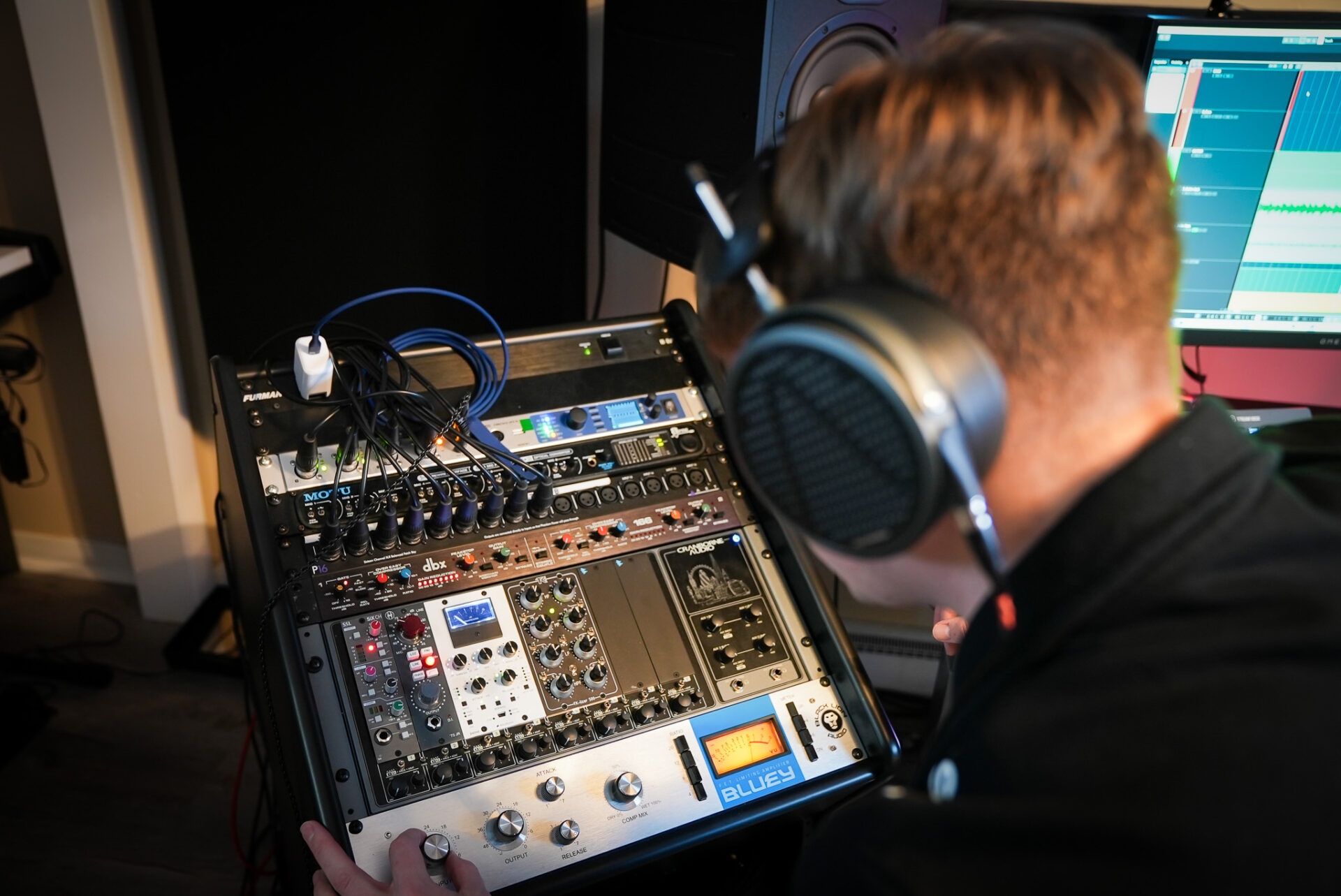The Black Lion Audio Bluey is one of the first hardware analog compressors I picked up for my home studio. As per recommendation from a mixer friend, I had to try it out. It’s heavy, and that’s often a good sign in the world of audio equipment.
Before diving into testing, my initial observations of the build quality were positive. The Bluey feels like it’s constructed to last, with a robust chassis that gives confidence in its longevity and performance. As someone who appreciates equipment that sounds good and is built to endure the rigors of regular use, this immediately stood out as a promising start.
Setting up the Bluey was straightforward. I was eager to rack this compressor and compare it with the 1176 clones and plugins I’ve used over the years. I was motivated to try the Bluey because of its association with Chris Lord-Alge, a renowned mixer known for his aggressive and colorful vocal sound. The Bluey is hardware replicating his uniquely modified 1176 Rev A, which explains its distinctiveness compared to other iterations.
I planned to conduct a series of tests using presets from the Waves CLA plugin based on Lord-Alge’s personal setup. By applying these settings, I aimed to see whether the hardware Bluey could capture the same character and aggressive compression style that intrigued me in the plugin.
With everything ready to go, I was set to explore how this piece of hardware translated the original’s unique modifications into tangible, sonic results.
Endorsement by Chris Lord-Alge
Chris Lord-Alge is a legend in the world of mixing. He is known for creating iconic vocal sounds that have defined countless records. My interest was immediately piqued when I heard about his endorsement of the Black Lion Audio Bluey.
Lord-Alge’s support for this gear is no small thing; it’s a nod of approval that carries weight in the professional audio community. His unique approach to the 1176 compressor has set a standard, and any piece of equipment bearing his stamp of approval is worth a closer look.
Comparison to the Waves CLA Plugin Series
I’ve been a long-time fan of the Waves CLA plugin series. Something about how these plugins capture the essence of the 1176 compressors resonates with me. The Bluey plugin, particularly, stands out due to its aggressive tone and vibrant saturation.
It mimics the fast attack and release characteristics crucial for that classic CLA sound. This affinity for the CLA plugins naturally led me to explore the hardware version of the Bluey to see if it could live up to the same expectations.
Unique Modifications in Chris’s Original 1176 Rev A
The story behind Chris Lord-Alge’s original 1176 Rev A is fascinating. Over the years, various modifications were made to the unit—some intentional and some accidental as it was maintained. These changes resulted in a compressor that was unlike any other.
The uniqueness of this particular 1176 is what inspired the Black Lion Audio Bluey. This wasn’t just another clone; it was a recreation of a one-of-a-kind piece of gear that influenced the sound of countless hit records.
Comparison with Other 1176 Clones
In my quest to find the perfect 1176-style compressor, I’ve tried several other modern clones. While they were decent in their own right, none truly captured the sound I was after. They fell short of the aggressive, colorful compression that I had come to associate with the CLA sound.
Many were good, but they didn’t have the character that set the Waves CLA plugin apart. This made me curious whether the Black Lion Audio Bluey could finally fill that gap in my setup. Given its lineage and the story behind its creation, it seemed like it had the potential to be the hardware equivalent of what I was hearing in the plugin world.
Initial Setup
Installation of the Bluey into the Rack
Getting the Black Lion Audio Bluey into my rack was the first step. As soon as I lifted it, I could tell it was a solid piece of hardware. Weight often speaks volumes about build quality, and the Bluey doesn’t disappoint.
It feels substantial and reassuring because lighter gear sometimes hints at cost-cutting measures in materials. Installing it was straightforward, though I ensured it was securely fastened, given its heft.
Absence of a Bypass, Presence of a Wet/Dry Blend
One thing I noticed right away is that the Bluey doesn’t come with a bypass switch. This isn’t too surprising, as some compressors omit this feature. However, what it does include is a wet/dry blend knob. This handy feature allows me to blend the compressed signal with the unprocessed signal.
I started with the knob at 0%, delivering a completely dry signal, and then gradually twisted it to 100% wet to fully engage the compressor. The wet/dry blend adds versatility, especially when subtlety is needed, or when I want to retain some of the original dynamics.
Using CLA Plugin Presets for Testing
For testing, I decided to use Chris Lord-Alge’s presets from the Waves CLA plugin series. Given that Chris Lord-Alge is the inspiration behind this hardware, it made sense to see how his settings translate from plugin to hardware.
The presets include specific attack, release, and ratio settings tailored for different instruments, so I applied these directly to the Bluey. I figured if anyone knew how this unit should sound, it would be the guy who inspired it.
I’ll use these settings as a baseline to evaluate Bluey’s performance across various tracks. By doing so, I can better understand how closely the hardware aligns with the digital emulation and what character it brings to the table.
Testing
Explanation of the Testing Process Using the Waves CLA Compressor Settings
To get a feel for the Black Lion Audio Bluey, I incorporated Chris Lord-Alge’s presets from the Waves CLA compressor plugin into my testing process. These presets offer a reliable benchmark, as they are derived from CLA’s own settings and are designed to replicate the distinctive sound he’s known for.
Since the Bluey is modeled after CLA’s unique 1176 Rev A, it made sense to use these presets as a guide to see how the hardware stacks up against its digital counterpart.
The testing began by carefully dialing the attack and release settings specified in the CLA presets. I then applied these settings across various instruments to assess how the Bluey responds to different audio sources.
This method helped me determine the accuracy of its emulation and how it adds character to the sound at varying compression levels.
Application of Presets on Different Instruments
I started with vocals. Using CLA’s vocal preset settings, I found that Bluey added confident assertiveness and presence to the aggressive and colorful voice. Even when applying minimal gain reduction, the character of Bluey was noticeable, enhancing the vocals with a slight saturation that made them stand out.
Next, I moved on to drums. I applied the Bluey to a mono drum room mic using the “all buttons in” mode, known for its distinctive, punchy sound. The results were impressive. The Bluey introduced a depth and warmth that was both vibrant and dynamic, with a saturation reminiscent of combining a compressor with a distortion unit like the Culture Vulture.
Finally, I tested the Bluey on an acoustic guitar track. I was keen to see how it handled more subtle, intricate sounds here. The Bluey did not disappoint, adding a rich warmth and slight compression that brought out the guitar’s natural resonance without overpowering it.
Sound and Color
One thing became abundantly clear throughout the testing: Bluey’s sound is unique and distinctly colored. Its aggressive compression style imparts a noticeable character to the audio, even at lower levels of gain reduction. This isn’t a transparent compressor, which makes it appealing for specific applications.
What stands out to me is how fast and responsive the Bluey is. It reacts quickly to transients and maintains tight control over the audio without losing its rich tonal characteristics. This speed, combined with its ability to break up sounds gently when pushed hard, makes it particularly suited for genres where a more aggressive, in-your-face sound is desirable.
Results and Impressions
Saturation and Speed
The Black Lion Audio Bluey stands out due to its distinctive saturation and speed characteristics. Unlike other compressors I’ve tried, the Bluey offers a fast response time, which lends itself well to maintaining the energy of a track.
This speed is particularly noticeable when using Chris Lord-Alge’s presets from the Waves CLA plugin. The Bluey doesn’t just compress; it interacts with the source material in a way that adds a unique, colorful character right from the first dB of gain reduction.
The saturation is pleasingly musical, reminiscent of using a Culture Vulture or Decapitator, especially when engaging the all-buttons mode. It’s aggressive but controlled, providing a nice balance of punch and color.
Comparison to Other Compressors
The differences are apparent when I compare the Bluey to the Audio Escape Opto Compressor. While the Audio Escape offers a beautiful, subtle sheen, the Bluey’s charm lies in its ability to provide a more pronounced color and character.
It’s more assertive, which might not always be the right choice, but it can be perfect for specific applications. Other 1176 clones I’ve tried, like the Retro 176, have their merits, but none seem to match the particular aggression and warmth the Bluey brings. This compressor doesn’t just add compression; it adds personality.
Potential Use Cases in Tracking
Given its assertive nature, I see the Bluey as an excellent choice for tracking aggressive vocals, particularly in rock or genres that benefit from a more upfront, colored sound. It’s also a great tool for drums, especially when you want a pronounced, slightly distorted sound that maintains the original performance’s clarity.
Although I haven’t had a chance to use it in tracking, I imagine it could be pretty beneficial when I desire to commit a certain vibe on the way in. However, I might still lean towards using the Audio Escape Opto Compressor for more subtle applications. The Bluey’s strength lies in its ability to elevate tracks where character and boldness are required.
Final Thoughts
The Black Lion Audio Bluey’s signature character and performance leave a lasting impression. From the outset, the Bluey stands out due to its unique ability to deliver an aggressive compression style akin to the famed CLA sound.
This compressor is not subtle; it imparts a distinct color even at minimal compression levels, which makes it perfect for adding a compelling edge to vocals or drums.
This unit’s speed and saturation are exceptional, with a responsiveness and break-up that feel both dynamic and musical. When set to all-buttons-in mode, the Bluey adds a rich saturation reminiscent of more distortion-focused gear, blending compression with a pleasing harmonic complexity.
Comparison to Other Colorful Compressors
In my experience, only a few compressors match the Bluey in terms of the character they add. The Retro Stay Level and the Retro 176 come to mind, both known for their capacity to saturate and color sound beautifully.
Yet, the Bluey’s edge lies in its specific recreation of the CLA vocal sound, which no other 1176 hardware or plugin emulator I’ve used quite captures. It’s a niche piece of gear, but it’s invaluable for those looking to nail that sound.
Value and Potential
The Black Lion Audio Bluey is undeniably a keeper. It fills a specific need for those chasing the iconic CLA sound, offering a level of character and aggression that is hard to find elsewhere.
Its quality and performance are impressive for the price, and it holds a firm place in my rack. Whether you’re working on rock vocals or looking to add a punchy, colorful edge to drums, the Bluey delivers with precision and flair. I am eager to explore it further and see how it continues to enhance my projects.

